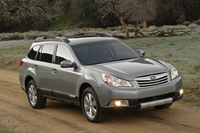2010 Subaru Legacy and Outback Vehicles Earn 2009 Top Safety Pick Awards
CHERRY HILL, NJ - August 27, 2009: The all-new 2010 Subaru Legacy and Subaru Outback have been named 2009 'Top Safety Picks' by the Insurance Institute of Highway Safety.
 Subaru Legacy |
"Building safe vehicles is one of the things our customers have come to know and expect from us," said Tom Doll, executive vice president and COO, Subaru of America, Inc. "To have this endorsement by the Insurance Institute of Highway Safety for every Subaru vehicle in our line-up is a tribute to our engineers and reinforces to consumers that we focus not only on manufacturing fun-to-drive vehicles, but also vehicles that are durable and dependable."
"Recognizing vehicles at the head of the class for safety helps consumers distinguish the best overall choices without having to sort through multiple test results," says Institute president Adrian Lund.
About IIHS
The Institute's frontal crashworthiness evaluations are based on results
of 40 mph frontal offset crash tests. Each vehicle's overall evaluation is
based on measurements of intrusion into the occupant compartment, injury
measures recorded on a Hybrid III dummy in the driver seat, and analysis of
slow-motion film to assess how well the restraint system controlled dummy
movement during the test.
Side evaluations are based on performance in a crash test in which the side of a vehicle is struck by a barrier moving at 31 mph. The barrier represents the front end of a pickup or SUV. Ratings reflect injury measures recorded on two instrumented SID-IIs dummies, assessment of head protection countermeasures, and the vehicle's structural performance during the impact. Injury measures obtained from the two dummies, one in the driver seat and the other in the back seat behind the driver, are used to determine the likelihood that a driver and/or passenger in a similar real-world crash would sustain serious injury to various parts of the body. The movements and contacts of the dummies' heads during the test also are evaluated. Structural performance is based on measurements indicating the amount of B-pillar intrusion into the occupant compartment.
Rear crash protection is rated according to a two-step procedure. Starting points for the ratings are measurements of head restraint geometry -- the height of a restraint and its horizontal distance behind the back of the head of an average-size man. Seats with good or acceptable restraint geometry are tested dynamically using a dummy that measures forces on the neck. This test simulates a collision in which a stationary vehicle is struck in the rear at 20 mph. Seats without good or acceptable geometry are rated poor overall because they can't be positioned to protect many people.



